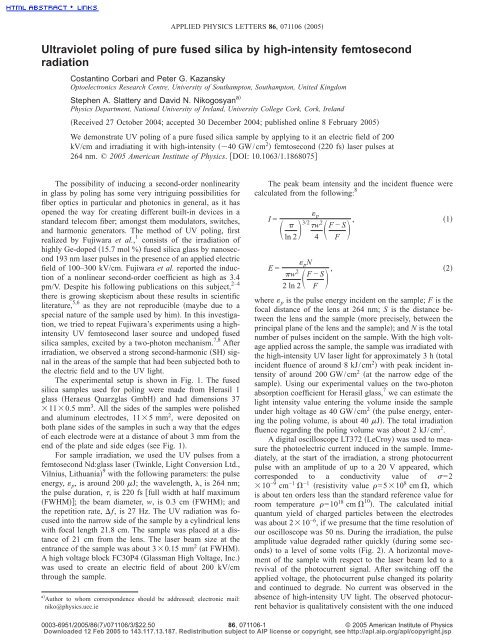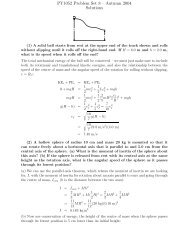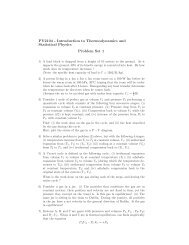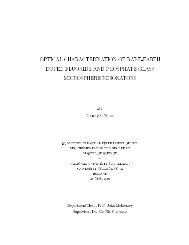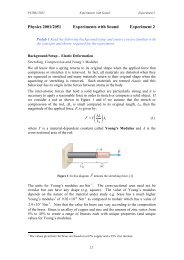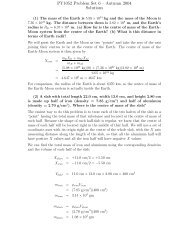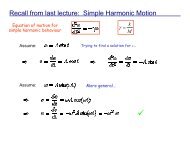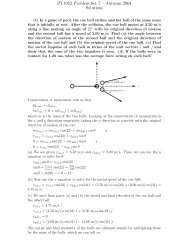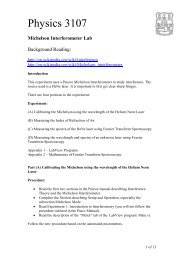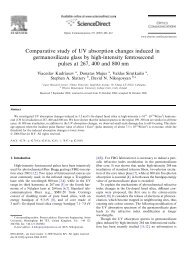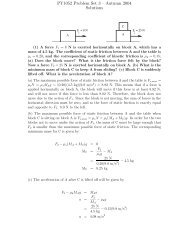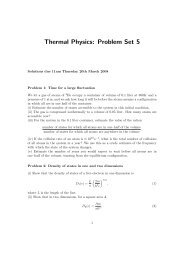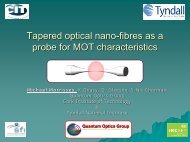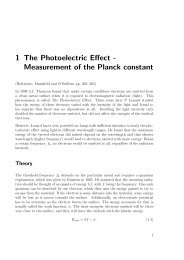Ultraviolet poling of pure fused silica by high-intensity femtosecond ...
Ultraviolet poling of pure fused silica by high-intensity femtosecond ...
Ultraviolet poling of pure fused silica by high-intensity femtosecond ...
Create successful ePaper yourself
Turn your PDF publications into a flip-book with our unique Google optimized e-Paper software.
APPLIED PHYSICS LETTERS 86, 071106 2005<strong>Ultraviolet</strong> <strong>poling</strong> <strong>of</strong> <strong>pure</strong> <strong>fused</strong> <strong>silica</strong> <strong>by</strong> <strong>high</strong>-<strong>intensity</strong> <strong>femtosecond</strong>radiationCostantino Corbari and Peter G. KazanskyOptoelectronics Research Centre, University <strong>of</strong> Southampton, Southampton, United KingdomStephen A. Slattery and David N. Nikogosyan aPhysics Department, National University <strong>of</strong> Ireland, University College Cork, Cork, IrelandReceived 27 October 2004; accepted 30 December 2004; published online 8 February 2005We demonstrate UV <strong>poling</strong> <strong>of</strong> a <strong>pure</strong> <strong>fused</strong> <strong>silica</strong> sample <strong>by</strong> applying to it an electric field <strong>of</strong> 200kV/cm and irradiating it with <strong>high</strong>-<strong>intensity</strong> 40 GW/cm 2 <strong>femtosecond</strong> 220 fs laser pulses at264 nm. © 2005 American Institute <strong>of</strong> Physics. DOI: 10.1063/1.1868075The possibility <strong>of</strong> inducing a second-order nonlinearityin glass <strong>by</strong> <strong>poling</strong> has some very intriguing possibilities forfiber optics in particular and photonics in general, as it hasopened the way for creating different built-in devices in astandard telecom fiber; amongst them modulators, switches,and harmonic generators. The method <strong>of</strong> UV <strong>poling</strong>, firstrealized <strong>by</strong> Fujiwara et al., 1 consists <strong>of</strong> the irradiation <strong>of</strong><strong>high</strong>ly Ge-doped 15.7 mol % <strong>fused</strong> <strong>silica</strong> glass <strong>by</strong> nanosecond193 nm laser pulses in the presence <strong>of</strong> an applied electricfield <strong>of</strong> 100–300 kV/cm. Fujiwara et al. reported the induction<strong>of</strong> a nonlinear second-order coefficient as <strong>high</strong> as 3.4pm/V. Despite his following publications on this subject, 2–4there is growing skepticism about these results in scientificliterature, 5,6 as they are not reproducible maybe due to aspecial nature <strong>of</strong> the sample used <strong>by</strong> him. In this investigation,we tried to repeat Fujiwara’s experiments using a <strong>high</strong><strong>intensity</strong>UV <strong>femtosecond</strong> laser source and undoped <strong>fused</strong><strong>silica</strong> samples, excited <strong>by</strong> a two-photon mechanism. 7,8 Afterirradiation, we observed a strong second-harmonic SH signalin the areas <strong>of</strong> the sample that had been subjected both tothe electric field and to the UV light.The experimental setup is shown in Fig. 1. The <strong>fused</strong><strong>silica</strong> samples used for <strong>poling</strong> were made from Herasil 1glass Heraeus Quarzglas GmbH and had dimensions 37110.5 mm 3 . All the sides <strong>of</strong> the samples were polishedand aluminum electrodes, 115 mm 2 , were deposited onboth plane sides <strong>of</strong> the samples in such a way that the edges<strong>of</strong> each electrode were at a distance <strong>of</strong> about 3 mm from theend <strong>of</strong> the plate and side edges see Fig. 1.For sample irradiation, we used the UV pulses from a<strong>femtosecond</strong> Nd:glass laser Twinkle, Light Conversion Ltd.,Vilnius, Lithuania 9 with the following parameters: the pulseenergy, p , is around 200 J; the wavelength, , is 264 nm;the pulse duration, , is 220 fs full width at half maximumFWHM; the beam diameter, w, is 0.3 cm FWHM; andthe repetition rate, f, is 27 Hz. The UV radiation was focusedinto the narrow side <strong>of</strong> the sample <strong>by</strong> a cylindrical lenswith focal length 21.8 cm. The sample was placed at a distance<strong>of</strong> 21 cm from the lens. The laser beam size at theentrance <strong>of</strong> the sample was about 30.15 mm 2 at FWHM.A <strong>high</strong> voltage block FC30P4 Glassman High Voltage, Inc.was used to create an electric field <strong>of</strong> about 200 kV/cmthrough the sample.a Author to whom correspondence should be addressed; electronic mail:niko@physics.ucc.ieThe peak beam <strong>intensity</strong> and the incident fluence werecalculated from the following: 8I =E = p ln 23/2 w 2 F − S , 14 F p Nw 22ln2 F − SF , 2where p is the pulse energy incident on the sample; F is thefocal distance <strong>of</strong> the lens at 264 nm; S is the distance betweenthe lens and the sample more precisely, between theprincipal plane <strong>of</strong> the lens and the sample; and N is the totalnumber <strong>of</strong> pulses incident on the sample. With the <strong>high</strong> voltageapplied across the sample, the sample was irradiated withthe <strong>high</strong>-<strong>intensity</strong> UV laser light for approximately 3 h totalincident fluence <strong>of</strong> around 8 kJ/cm 2 with peak incident <strong>intensity</strong><strong>of</strong> around 200 GW/cm 2 at the narrow edge <strong>of</strong> thesample. Using our experimental values on the two-photonabsorption coefficient for Herasil glass, 7 we can estimate thelight <strong>intensity</strong> value entering the volume inside the sampleunder <strong>high</strong> voltage as 40 GW/cm 2 the pulse energy, enteringthe <strong>poling</strong> volume, is about 40 J. The total irradiationfluence regarding the <strong>poling</strong> volume was about 2 kJ/cm 2 .A digital oscilloscope LT372 LeCroy was used to measurethe photoelectric current induced in the sample. Immediately,at the start <strong>of</strong> the irradiation, a strong photocurrentpulse with an amplitude <strong>of</strong> up to a 20 V appeared, whichcorresponded to a conductivity value <strong>of</strong> =210 −9 cm −1 −1 resistivity value =510 8 cm , whichis about ten orders less than the standard reference value forroom temperature =10 18 cm 10 . The calculated initialquantum yield <strong>of</strong> charged particles between the electrodeswas about 210 −6 , if we presume that the time resolution <strong>of</strong>our oscilloscope was 50 ns. During the irradiation, the pulseamplitude value degraded rather quickly during some secondsto a level <strong>of</strong> some volts Fig. 2. A horizontal movement<strong>of</strong> the sample with respect to the laser beam led to arevival <strong>of</strong> the photocurrent signal. After switching <strong>of</strong>f theapplied voltage, the photocurrent pulse changed its polarityand continued to degrade. No current was observed in theabsence <strong>of</strong> <strong>high</strong>-<strong>intensity</strong> UV light. The observed photocurrentbehavior is qualitatively consistent with the one induced0003-6951/2005/867/071106/3/$22.5086, 071106-1© 2005 American Institute <strong>of</strong> PhysicsDownloaded 12 Feb 2005 to 143.117.13.187. Redistribution subject to AIP license or copyright, see http://apl.aip.org/apl/copyright.jsp
071106-2 Corbari et al. Appl. Phys. Lett. 86, 071106 2005FIG. 1. Schematic <strong>of</strong> UV <strong>poling</strong> experiment with induced photocurrentmeasurement.in earlier experiments on the two-step ionization S 0 →S 1→S N <strong>of</strong> oxygen deficient <strong>fused</strong> <strong>silica</strong> <strong>by</strong> KrF excimer laserradiation with =248 nm and =25 ns. 11After <strong>poling</strong> and removal <strong>of</strong> the electrodes <strong>by</strong> etching,the sample was tested for evidence <strong>of</strong> second-harmonic generation.As a source <strong>of</strong> fundamental radiation, a mode-lockedand Q-switched Nd:YAG laser was used =1064 nm. Forthe Maker’s fringe measurement, 12 the sample was placed ona rotation stage and the laser beam was focused on the poledarea, with the polarization parallel to the plane <strong>of</strong> incidence.The generated SH light was detected with a photomultplier.The measurement <strong>of</strong> the periodicity <strong>of</strong> the fringes in theMaker’s fringe pattern allows us to determine the thickness<strong>of</strong> the poled region in the sample. The fit to the experimentaldata Fig. 3 reveals that the region with an induced 2nonlinearity corresponds to the whole bulk volume betweenthe two electrodes. The comparison <strong>of</strong> the SH signal valuewith that obtained from the reference sample crystallinequartz with a known 2 value <strong>of</strong> 0.6 pm/V, 13 allowed us toestimate the maximum value <strong>of</strong> the induced second-ordernonlinearity as about 0.02 pm/V. A rectification model 14gives for the induced second-order nonlinearity a value <strong>of</strong> 2 =3 3 E dc ,3where 3 is the third-order nonlinear susceptibility, equal to410 −22 m 2 V −2 for <strong>fused</strong> <strong>silica</strong>, 15 and E dc is the appliedelectric field. If we take E dc equal to 200 kV/cm, we willFIG. 3. Maker’s fringe pattern registered in the poled sample <strong>of</strong> Herasilglass.obtain a predicted 2 value <strong>of</strong> 0.024 pm/V, which is inremarkable agreement with the measured one. If the sameexperiment is performed in twin-hole fibers, 16 where themaximum applied field would be only limited <strong>by</strong> the dielectricstrength <strong>of</strong> <strong>silica</strong> at room temperature 310 8 V/m, 17710 8 V/m, 18 10 9 V/m 16 , we can tentatively predict avalue <strong>of</strong> 2 , reaching 1 pm/V.We also scanned the pump beam across the surface <strong>of</strong>the sample to test the distribution <strong>of</strong> the second-order nonlinearity,using the setup described in our earlier work 19 Fig.4. The geometry was the same as for the Maker’s fringemeasurements described earlier. The angle <strong>of</strong> incidence waschosen to be close to normal incidence 10° to reduce theeffects <strong>of</strong> nonuniformities. A stronger SH signal is observednear the side where the laser beam entered the sample whichcould be explained <strong>by</strong> the decrease <strong>of</strong> UV <strong>intensity</strong> caused<strong>by</strong> two-photon absorption in the glass. During the inscriptionprocedure, we poled several regions under the electrodes <strong>by</strong>FIG. 4. The two-dimensional distribution <strong>of</strong> the second-harmonic signal inthe poled <strong>fused</strong> <strong>silica</strong> sample. The sample geometry is marked <strong>by</strong> the blackFIG. 2. Oscillogram <strong>of</strong> an induced photocurrent signal together with <strong>femtosecond</strong>UV pulse.The UV beam entered the sample from the left.lines and the area covered <strong>by</strong> the electrodes is marked <strong>by</strong> the white lines.Downloaded 12 Feb 2005 to 143.117.13.187. Redistribution subject to AIP license or copyright, see http://apl.aip.org/apl/copyright.jsp
071106-3 Corbari et al. Appl. Phys. Lett. 86, 071106 2005translating the sample. It is clearly seen that the secondharmonicsignal is observed only in the area under the electrodesilluminated <strong>by</strong> the UV light beam, indicating that the<strong>poling</strong> takes place only under the simultaneous action <strong>of</strong> bothUV light and the applied electric field.In conclusion, using <strong>high</strong>-<strong>intensity</strong> 40 GW/cm 2 <strong>femtosecond</strong>UV light combined with a <strong>high</strong> electric field 200kV/cm we were able to induce a second-order nonlinearity<strong>of</strong> 0.02 pm/V in undoped <strong>fused</strong> <strong>silica</strong>.The authors want to thank Dr. Alastair Glass for bringingtheir attention to this interesting area and for useful discussions.Christie Roche and John Lucy are acknowledged forexcellent technical assistance and the Science FoundationIreland for their generous financial support Grant No. 0.1/IN.1/IO58.1 T. Fujiwara, M. Takahashi, and A. J. Ikushima, Appl. Phys. Lett. 71, 10321997.2 T. Fujiwara, M. Takahashi, and A. J. Ikushima, Electron. Lett. 33, 9801997.3 M. Ohama, T. Fujiwara, and A. J. Ikushima, Jpn. J. Appl. Phys., Part 1 38,6359 1999.4 T. Fujiwara, S. Matsumoto, M. Ohama, and A. J. Ikushima, J. Non-Cryst.Solids 273, 203 2000.5 W. Margulis, F. C. Garcia, E. N. Hering, L. C. Guedes Valente, B. Lesche,F. Laurell, and I. C. S. Carvalho, MRS Bull. 23, 311998.6 W. Hu, P. Blaszkiewicz, and S. Fleming, Adv. Mater. Weinheim, Ger.13, 1014 2001.7 A. Dragomir, J. G. McInerney, D. N. Nikogosyan, and P. G. Kazansky,Appl. Phys. Lett. 80, 1114 2002.8 A. Dragomir, J. G. McInerney, and D. N. Nikogosyan, Appl. Opt. 41,4365 2002.9 Twinkle, <strong>high</strong>ly integrated pico/<strong>femtosecond</strong> CPA Nd:glass laser system,http://www.lightcon.com/lc/scientific/laser.htm.10 Quartz Glass for Optics, Data and Properties Heraeus Quarzglas, 1994.11 V. N. Bagratashvili, S. I. Tsypina, P. V. Chernov, A. O. Rybaltovskii, Y. S.Zavorotny, S. S. Alimpiev, Y. O. Simanovskii, L. Dong, and P. S. J.Russell, Appl. Phys. Lett. 68, 1616 1996.12 J. Jerphagnon and S. K. Kurtz, J. Appl. Phys. 41, 1667 1970.13 D. N. Nikogosyan, Properties <strong>of</strong> Optical and Laser-Related Materials. AHandbook Wiley, Chichester, 1997, p.167.14 P. G. Kazansky and P. S. J. Russell, Opt. Commun. 110, 6111994.15 F. Kaizar and J. Messier, Rev. Sci. Instrum. 58, 2081 1987.16 P. G. Kazansky and V. Pruneri, Phys. Rev. Lett. 78, 2956 1997.17 N. Myren, H. Olsson, L. Norin, N. Sjödin, P. Helander, J. Svennebrink,and W. Margulis, Opt. Express 12, 6093 2004.18 G. W. McLellan and E. B. Strand, Glass Engineering Handbook, 3rd ed.McGraw–Hill, New York, 1984, pp. 2–45.19 C. Corbari, J. D. Mills, O. Deparis, B. G. Klappauf, and P. G. Kazansky,Appl. Phys. Lett. 81, 1585 2002.Downloaded 12 Feb 2005 to 143.117.13.187. Redistribution subject to AIP license or copyright, see http://apl.aip.org/apl/copyright.jsp


